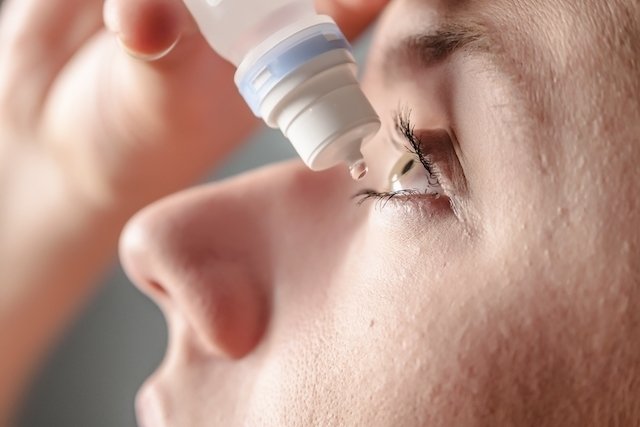Eye drops for glaucoma are adrenergic agonists, beta blockers, prostaglandin analogues or cholinergic agonists, such as brimonidine tartrate, timolol maleate or bimatoprost, for example.
These eye drops have the function of reducing pressure in the eyes or intraocular pressure, which is increased in cases of glaucoma, and are generally used for life to control the disease and prevent blindness, which is its main complication, caused by nerve damage. optical.
Glaucoma eye drops should be used under the advice of an ophthalmologist, according to the type of glaucoma and characteristics of each person, such as asthma, heart problems or bronchitis, for example, and even if they cause side effects, the product must continue to be used correctly. medication until you speak to your ophthalmologist to assess whether changes can be made to your treatment.

Main eye drops for glaucoma
The main eye drops for glaucoma are:
1. Adrenergic agonists
These eye drops act by reducing the production of aqueous humor and, at a later stage, lead to increased drainage of aqueous humor, which leads to a reduction in intraocular pressure.
An example of an adrenergic agonist eye drop is brimonidine tartrate, found under the trade names Alphagan, Glaub or Alphabrin.
Side effects: headache, dry mouth, tiredness, redness, burning and stinging eyes, blurred vision, foreign body sensation in the eyes, folliculosis, ocular allergic reactions and itchy eyes.
Make an appointment with an ophthalmologist in the nearest region:
2. Beta blockers
Beta blockers work by reducing intraocular pressure, which ultimately reduces intraocular pressure.
An example of beta-blocking eye drops for glaucoma is timolol maleate, found under the names Tenoftal, Glaucotrat or Glautimol.
Side effects: corneal anesthesia, blurred vision, decreased blood pressure, reduced heart rate and fatigue. In people with a history of asthma, it may also cause mild shortness of breath.
3. Prostaglandin analogues
They work by increasing the drainage of aqueous humor, which helps reduce intraocular pressure.
Some examples of prostaglandin analog eye drops for glaucoma are bimatoprost (Lumigan), latanoprost (Xalatan), travoprost (Travatan).
Side effects: burning, blurred vision, eye redness, itching and burning.
4. Carbonic anhydrase inhibitors
These remedies act by inhibiting the secretion of aqueous humor, by inhibiting carbonic anhydrase, thus reducing intraocular pressure.
Some examples of carbonic anhydrase inhibitor eye drops for glaucoma are dorzolamide (Andrum or Dorzal) and brinzolamide (Azopt).
Side effects: Burning, burning and clouding in the eyes.
5. Cholinergic agonists
Cholinergic agonists act by decreasing resistance to the passage of aqueous humor, which leads to a reduction in intraocular pressure. However, these eye drops are no longer used for the long-term treatment of glaucoma due to their side effects.
Some cholinergic agonist eye drops for glaucoma are pilocarpine and carbachol, for example.
Side effects: ciliary spasm, eye irritation, conjunctival vascular congestion, headache and eye pain, ocular hyperemia, reduced vision capacity under poor lighting and induction of myopia, especially in young people.
6. Rho-kinase inhibitors
Rho-kinase inhibitors are eye drops that act by increasing the drainage of aqueous humor, which helps reduce intraocular pressure.
The rho-kinase inhibitor eye drops for glaucoma, used in other countries, is netarsudil, which is not yet available in Brazil.
Side effects: redness of the eyes, itching, deposits on the cornea and small bleeds in the sclera, which is the white part of the eye.
7. Combined formulas
Combined formulas are eye drops that use more than one type of active ingredient, making them a good option for people who need more than one type of medication for glaucoma.
Some examples of combined eye drops for glaucoma are Cosopt, Combigan or Simbrinza, for example.
Side effects: These eye drops may have side effects that vary depending on the combination of active ingredients.
How to use correctly
To use glaucoma eye drops correctly, you must follow some steps, such as:
- Wash your hands well with water and neutral soap;
- Tilt your head back and look up;
- Lower the lower eyelid, like one of the hands, forming a kind of bag;
- Hold the eye drop bottle upside down, with the other hand, pointing it at the small pocket formed when pulling the lower eyelid. You should avoid touching the eye with the tip of the bottle;
- Add the amount of drops recommended by the ophthalmologist;
- Close your eyes by lightly pressing the corner of your eye for 1 minute.
If it is necessary to use different eye drops, you must wait at least 5 minutes between each application.
Furthermore, to prevent infections, it is important to prevent the tip of the eye drop bottle from becoming contaminated. Therefore, you should not touch the tip of the bottle with your hand or touch the tip of the bottle to your eye, eyelid or any other surface.
Food to aid treatment
To help control the disease, you must maintain a balanced diet, rich in antioxidant foods and important nutrients for the eyes, such as vitamins A, C and E, and minerals, such as zinc and selenium.
These nutrients are mainly present in foods such as oranges, pineapple, carrots, acerola, pumpkin, strawberries, goji berries and raspberries. Furthermore, by improving circulation and having antioxidant action, cranberries also help to improve night vision and eye brightness, and can be used to alleviate the symptoms of glaucoma.
It is also important to avoid consuming foods rich in sugar and large amounts of salt and caffeine, as these lead to increased blood pressure and eye pressure.
Physical activity combats high blood pressure in the eyes
Frequent physical activity helps reduce pressure in the eye and control risk factors for glaucoma, such as diabetes and high blood pressure. Therefore, it is recommended to do exercises such as walking or cycling for at least 40 minutes, 4 times a week.
Furthermore, it is important to avoid exercising in positions that place the body upside down, as in yoga or Pilates classes, for example, as this can increase pressure in the head and eyes, making it necessary to seek medical authorization before practicing. this type of physical activity.
See other types of treatment for glaucoma.
Also watch the following video and better understand what glaucoma is and how to identify it:



